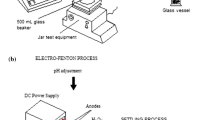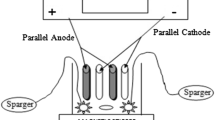Abstract
A large portion of water is consumed during various textile operations thereby discharging wastewaters with pollutants of huge environmental concern. The treatment of such wastewaters has promising impact in the field of environmental engineering. In this work, Fenton oxidation treatment was engaged to treat simulated textile wastewater. Box–Behnken design and response surface methodology were employed to optimize the efficiency of Fenton process. Iron dose, peroxide dose and pH were considered as input variables while the responses were taken as chemical oxygen demand and color removal. A total of 17 experiments were conducted and analyzed using second-order quadratic model. The quadratic models generated for chemical oxygen demand and color removal efficiencies were validated using analysis of variances, and it was found that the experimental data fitted the second-order model quite effectively. Analysis of variances demonstrated high values of coefficient of determination (R 2) for chemical oxygen demand and color removal efficiencies with values of 0.9904 and 0.9963 showing high conformation of predicted values to the experimental ones. Perturbation plots suggested that the iron dosage produced the maximum effect on both chemical oxygen demand and color removal efficiencies. The optimum parameters were determined as Fe2+ dose—550 mg/L, H2O2 dose—5538 mg/L, pH—3.3 with corresponding chemical oxygen demand and color removal efficiencies of 73.86 and 81.35%. Fenton process was found efficient in treatment of simulated textile wastewater, and optimization using response surface methodology was found satisfactory as well as relevant. From the present study, it can also be concluded that if this method is used as pretreatment integrated with biological treatment, it can lead to eco-friendly solution for treatment of textile wastewaters.







Similar content being viewed by others
References
Alim M, Lee J, Akoh C, Choi M, Jeon M, Shin J, Lee K (2008) Enzymatic transesterification of fractionated rice bran oil with conjugated linoleic acid: optimization by response surface methodology. LWT Food Sci Technol 41:764–770
Alinsafi A, Evenou F, Abdulkarim EM, Pons MN, Zahraa O, Benhammou A, Nejmeddine A (2007) Treatment of textile industry wastewater by supported photocatalysis. Dyes Pigm 74(2):439–445
Anderson M, Whitcomb P (2007) DOE simplified: practical tools for effective experimentation, 2nd edn. Productive Press, New York
Arslan-Alaton I, Tureli G, Olmez-Hanci T (2009) Treatment of azo dye production wastewaters using Photo-Fenton-like advanced oxidation processes: optimization by response surface methodology. J PhotoChem PhotoBiol A Chem 202:142–153
Azami M, Bahram M, Nouri S, Naseri A (2012) A central composite design for the optimization of the removal of the azo dye, methyl orange, from wastewater using the Fenton reaction. J Serb Chem Soc 77:235–246
Babuponnusami A, Muthukumar K (2014) A review on Fenton and improvements to the Fenton process for wastewater treatment. J Envrion Chem Eng 2:557–572
Bahmani P, Maleki A, Ghahramani E, Rashidi A (2013) Decolorization of the dye reactive black 5 using Fenton oxidation. Afr J Biotechnol 12(26):4115–4122
Baş D, Boyaci İ (2007) Modelling and optimization I: usability of response surface methodology. J Food Eng 78:836–845
Bianco B, Michelis I, Vegliǒ F (2011) Fenton treatment of complex industrial wastewater: optimization of process conditions by response surface method. J Hazard Mater 186:1733–1738
Blanco J, Torrades F, Varga D, García-Montaño J (2012) Fenton and biological-fenton coupled processes for textile wastewater treatment and reuse. Desalination 286:394–399
Carlson R, Carlson J (2005) Design and optimization in organic synthesis. Elsevier, Amsterdam
Chung K, Fulk G, Egan M (1978) Reduction of azo dyes by intestinal anaerobes. Appl Environ Microbiol 35:558–562
Clarke E, Anliker R (1980) Organic dyes and pigments. Handbook of environmental chemistry. Part A: anthropogenic compounds. Springer, New York, pp 181–215
Cristovao R, Tavares A, Brigida A, Loureiro J, Boaventura R, Macedo E, Coelho M (2011) Immobilization of commercial laccase onto green coconut fiber by adsorption and its application for reactive textile dyes degradation. J Mol Catal B Enzym 72:6–12
Dos Santos A, Cervantes F, van Lier J (2007) Review paper on current technologies for decolourisation of textile wastewaters: perspectives for anaerobic biotechnology. Bioresour Technol 98:2369–2385
Emami F, Tehrani-Bagha A, Gharanjig K, Menger F (2010) Kinetic study of the factors controlling Fenton-promoted destruction of a non-biodegradable dye. Desalination 257:124–128
Fathinia M, Khataee A, Zarei M, Aber S (2010) Comparative photocatalytic degradation of two dyes on immobilized TiO2 nanoparticles: effect of dye molecular structure and response surface approach. J Mol Catal A Chem 333:73–84
Garca-Montano J, Torrades F, Garca-Hortal J, Domenech X, Peral J (2006) Degradation of Procion Red H-E7B reactive dye by coupling a photo-Fenton system with a sequencing batch reactor. J Hazard Mater 134:220–229
GilPavas E, Dobroz- Gǒmez I, Gǒmez- Garcĭa M (2012) Decolorization and mineralization of Diarylide Yellow 12 (PY12) by photo-Fenton process: the response surface methodology as the optimization tool. Water Sci Technol 65:1795–1800
Hsueh C, Huang Y, Wang C, Chen S (2005) Degradation of azo dyes using low iron concentration of Fenton and Fenton-like system. Chemosphere 58(10):1409–1414
Isik M, Sponza D (2008) Anaerobic/aerobic treatment of a simulated textile wastewater. Sep Curif Technol 60:64–72
Kavitha V, Palanivelu K (2005) Destruction of cresols by Fenton oxidation process. Water Res 39:3062–3072
Khataee A, Safarpour M, Naseri A, Zarei M (2012) Photoelectro-Fenton/nanophotocatalysis decolorization of three textile dyes mixture: response surface modeling and multivariate calibration procedure for simultaneous determination. Electroanal Chem 672:53–62
Kwon B, Lee D, Kang N, Yoon J (1999) Characteristics of p-chrolophenol oxidation by Fentons reagent. Water Res 33:2110–2118
Lodha B, Chaudhari S (2007) Optimization of Fenton-biological treatment scheme for the treatment of aqueous dye solutions. J Hazard Mater 148:459–466
Lucas M, Peres J (2006) Decolorization of the Azo dye reactive black 5 by Fenton and Photo-Fenton oxidation. Dyes Pigm 71:236–244
Mansoorian HJ, Bazrafshan E, Yari A, Alizadeh M (2014) Removal of Azo dyes from aqueous solution using Fenton and modified Fenton processes. Health Scope 3(2):e15507
Mason R, Gunst R, Hess J (2003) Statistical design and analysis of experiments. Eighth applications to engineering and science, 2nd edn. Wiley, New York
Meric S, Kaptan D, Olmez T (2004) Color and COD removal from wastewater containing reactive black 5 using Fenton oxidation process. Chemosphere 54:435–441
Moghaddam SS, Moghaddam M, Arami M (2010) Coagulation/flocculation process for dye removal using sludge from water treatment plant: optimization through response surface methodology. J Hazard Mater 175:651–657
Montogomery D (2010) Design and analysis of experimenters, 7th edn. Wiley India Pvt Ltd, New Delhi
Myers R, Montgomery D (2002) Response surface methodology: process and product optimization using designed experiments, 2nd edn. Wiley, New York
Nair A, Makwana A, Ahammed M (2014) The use of response surface methodology for modelling and analysis of water and wastewater treatment processes: a review. Water Sci Technol 69(3):464–478
Nawaz MS, Ahsan M (2014) Comparison of physico-chemical, advanced oxidation and biological techniques for the textile wastewater treatment. Alex Eng J 53(3):717–722
Nidheesh P, Gandhimathi R, Ramesh S (2013) Degradation of dyes from aqueous solution by Fenton processes: a review. Environ Sci Pollut R 20:2099–2132
Puvaneswari N, Muthukrishnan J, Gunasekaran P (2006) Toxicity assessment and microbial degradation of azo dyes. Indian J Exp Biol 44:618–626
Rodrigues C, Madeira L, Boaventura R (2009) Treatment of textile effluent by chemical (Fenton’s reagent) and biological (sequencing batch reactor) oxidation. J Hazard Mater 172:1551–1559
Rosales E, Sanromàn M, Pazos M (2012) Application of central composite face-centered design and response surface methodology for the optimization of electro-Fenton decolorization of Azure B dye. Environ Sci Pollut Res 19:1738–1746
Sakkas V, Islam M, Stalikas C, Albanis T (2010) Photocatalytic degradation using design of experiments: a review and example of the Congo red degradation. J Hazard Mater 175:33–44
Saldańa-Robles A, Guerra-Sànchez R, Maldonado-Rubio M, Peralta-Hernàndez J (2014) Optimization of the operating parameters using RSM for the Fenton oxidation process and adsorption on vegetal carbon of MO solutions. J Ind Eng Chem 20:848–857
Sarabia L, Ortiz M (2009) Response surface methodology. In: Brown SD, Tauler R, Walczak B (eds) Comprehensive chemometrics: chemical and biochemical data analysis, vol 1. Elsevier, Amsterdam, pp 345–390
Sevimli MF, Sarikaya HZ (2002) Ozone treatment of textile effluents and dyes: effect of applied ozone dose, pH and dye concentration. J Chem Technol Biotechnol 77(7):842–850
Sun J, Sun S, Sun R, Qiao L, Guo H, Fan M (2007) Degradation of azo dye Acid Black 1 using low concentration iron of Fenton process facilitated by ultrasonic irradiation. J Ult Sonochem 14:761–766
Tunay O, Kabdasli I, Eremetkar G, Orhon D (1996) Color removal from textile wastewaters. Water Sci Technol 34(11):9–16
Ugyur A, Kök E (1999) Decolorization treatments of azo dyes wastewaters including dichlorotriazinyl reactive groups by using advanced oxidation method. J Soc Dye Colour 115:350–354
Wang C, Chou W, Chung M, Kuo Y (2010) COD removal from real dyeing wastewater by electro-Fenton technology using an activated carbon fiber cathode. Desalination 253(1–3):129–134
Welham A (2000) The theory of dyeing (and the secret of life). J Soc Dye Colour 116:140–143
Xu H, Qi S, Li Y, Zhao Y, Li J (2013) Heterogenous Fenton-like discoloration of Rhodamine B using natural schorl as catalyst: optimization by response surface methodology. Environ Sci Pollut Res 20:5764–5772
Yadav A, Mukherji S, Garg A (2013) Removal of chemical oxygen demand and color from simulated textile wastewater using a combination of chemical/physicochemical processes. Ind Eng Chem Res 52(30):10063–10071
Zhang H, Choi H, Huang C (2005) Optimization of Fenton process for the treatment of landfill leachate. J Hazard Mater 125(1–3):166–174
Zhou M, Yu Q, Lei L, Barton G (2007) Electro-Fenton method for the removal of methyl red in an efficient electrochemical system. Sep Purif Technol 57(2):380–387
Zhu X, Tian J, Liu R, Chen L (2011) Optimization of Fenton and electro-Fenton oxidation of biologically treated coking wastewater using response surface methodology. Sep Purif Technol 81:444–450
Acknowledgements
First of all, I would like to thank God, without his blessings my work would not have been completed. I am immensely grateful and thankful to my guide. He not only provided great support for my work, but was also a constant source of inspiration and encouragement. He arranged all the possible support when I was in need of it. I heartily thank him for his guidance throughout my work.
Author information
Authors and Affiliations
Corresponding author
Additional information
Editorial responsibility: M. Abbaspour.
Electronic supplementary material
Below is the link to the electronic supplementary material.
Rights and permissions
About this article
Cite this article
Sharma, S., Kapoor, S. & Christian, R.A. Effect of Fenton process on treatment of simulated textile wastewater: optimization using response surface methodology. Int. J. Environ. Sci. Technol. 14, 1665–1678 (2017). https://doi.org/10.1007/s13762-017-1253-y
Received:
Revised:
Accepted:
Published:
Issue Date:
DOI: https://doi.org/10.1007/s13762-017-1253-y




